A facile random copolymer strategy to achieve highly conductive polymer gel electrolytes for electrochemical applications†
Abstract
A facile random copolymer strategy based on poly(styrene-ran-methyl methacrylate) (PS-r-PMMA) is proposed for the preparation of highly conductive and mechanically elastic solid-state gel electrolytes. In contrast to previous random copolymers serving as polymer hosts, PS-r-PMMA can be readily synthesized by one-pot reversible additional–fragmentation chain transfer (RAFT) polymerization. PS-r-PMMA and the ionic liquid 1-ethyl-3-methylimidazolium bis(trifluoromethylsulfonyl)imide ([EMI][TFSI]) are blended to fabricate physically cross-linked ion gel electrolytes. We systematically investigate the dependence of gel properties on experimental variables, such as the styrene fraction and molecular weight of PS-r-PMMAs, and the ion gel composition. The physical properties of the gels are optimized to simultaneously exhibit good ionic conductivity (∼0.98 mS cm−1) and mechanical resilience (∼7.2 × 104 Pa) at room temperature. The versatility of the PS-r-PMMA-based gels as a solid-state electrolyte platform is successfully demonstrated by applying it in two types of electrochemical devices, electrochemiluminescent (ECL) and electrochromic (EC) displays. These results imply that PS-r-PMMAs can be easily synthesized without post reactions and are a simple and effective polymer host for high-performance ion gel electrolytes for diverse electrochemical applications.

- This article is part of the themed collection: 2019 Journal of Materials Chemistry C Most Popular Articles


 Please wait while we load your content...
Please wait while we load your content...